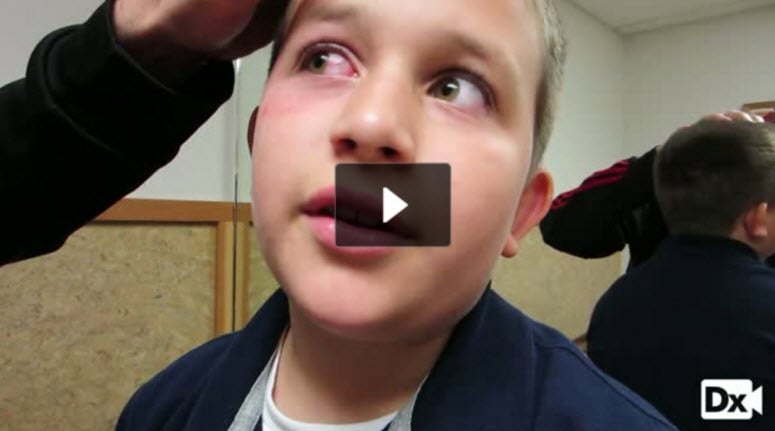

8 y/o with eye pain and redness
Patient will present as → a 10-year-old boy who was hit in the right eye with a piece of bark that was thrown on the playground. He developed sudden onset of eye pain, photophobia, tearing, and blurring of vision. He claims there is "something stuck in my eye." On physical examination, there is significant conjunctival injection.
A corneal abrasion is a superficial scratch on the clear, protective "window" at the front of your eye (cornea)
- Corneal abrasions are the most common ophthalmologic visit to the emergency department and are a commonly seen problem in urgent care
- Corneal abrasions most commonly result from accidental trauma (e.g., fingernail scratch, makeup brush): dirt, sand, sawdust, or other foreign body gets caught under the eyelid
Diagnose with fluorescein staining - increased absorption in the devoid area
- Must be able to differentiate corneal abrasion from a corneal ulcer – They will appear different on an exam, ulcers are often visible without fluorescein, and abrasions will be seen on fluorescein often as a thin line
Topical anesthetic - immediate relief (do not dispense). Treat with topical antibiotic ointment (preferable to drops) as lubrication will likely help.
- Ophthalmic antibiotics
- For patients who are NOT contact lens wearers, erythromycin ointment (Ilotycin, Diomycin, Erocin) is a good choice, used four times daily for three to five days.
- Contact lens wearers with corneal abrasions require an antibiotic with optimal antipseudomonal coverage (eg, ciprofloxacin, ofloxacin, or if fluoroquinolones are not available, tobramycin or gentamicin).
- Patching for corneal abrasions is generally no longer recommended because it may delay corneal healing
- Follow up daily. Refer if large or central
Question 1 |
Acute angle-closure glaucoma Hint: Presents with severe eye pain but is associated with blurred vision and halos around lights, not typically related to trauma. | |
Chemical burn Hint: Would involve a history of exposure to a chemical substance. | |
Infectious keratitis Hint: Usually develops over a longer period and not immediately after trauma. | |
Corneal abrasion | |
Uveitis Hint: Inflammation inside the eye, not typically caused by superficial trauma. |
Question 2 |
Slit-lamp examination with fluorescein staining | |
Intraocular pressure measurement Hint: Important in glaucoma but not primarily for diagnosing corneal abrasion. | |
Fundoscopic examination Hint: Used to examine the internal structures of the eye, not the cornea. | |
CT scan of the orbit Hint: Indicated in cases of suspected orbital fractures or deep foreign bodies. | |
Schirmer's test Hint: Measures tear production, not relevant for diagnosing corneal abrasions. |
Question 3 |
Patching the affected eye Hint: No longer routinely recommended for small corneal abrasions. | |
Systemic antibiotics Hint: Not necessary for uncomplicated corneal abrasions. | |
Steroid eye drops Hint: Not indicated in the initial treatment of corneal abrasions and can delay healing. | |
Immediate surgical intervention Hint: Reserved for severe ocular injuries, not small corneal abrasions. | |
Topical antibiotic ointment and pain management |
Question 4 |
Prescribing ophthalmic antibiotics Hint: These are typically indicated in the treatment of corneal abrasions to prevent bacterial infections, especially when the abrasion is due to organic material. | |
Applying a pressure patch to the affected eye | |
Conducting an examination for visual acuity Hint: Assessing visual acuity is an important part of the ocular examination and is not harmful. | |
Performing copious irrigation of the eye Hint: This is an appropriate initial step, especially if there is a concern for contamination with foreign material, to help remove any remaining particles. | |
Prescribing topical nonsteroidal anti-inflammatory drugs (NSAIDs) Hint: While these can be used for pain management, they are not inherently harmful in the treatment of corneal abrasions, unless contraindicated. |
|
List |
References: Merck Manual · UpToDate


